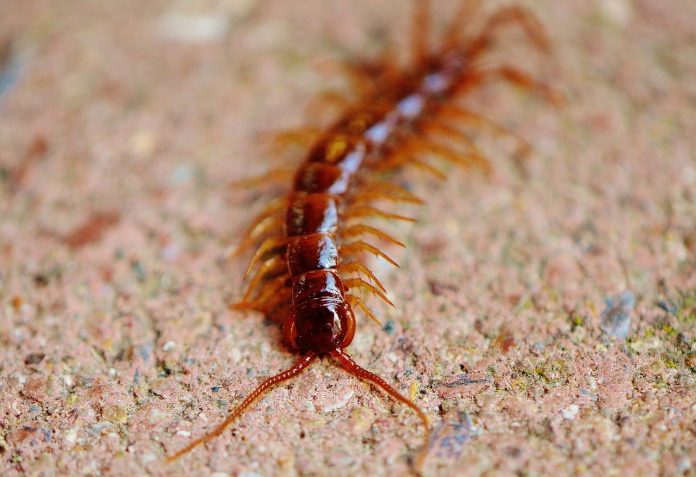One of my first childhood memories is getting ready for a bath and finding a two-inch long “thousand-legger” in the tub.
My reaction was to catch it and put it in a jar, but mom always grabbed some tissue paper, squished it and flushed it down the toilet.
If she had just scooped it out of the tub and let it roam the house, we would have been better off. Centipedes (approximately 2,500 species worldwide) are predators and eat all kinds of household pests.
Common house centipedes, the species that appears in bathtubs or on kitchen floors, eat a variety of household insect pests, including cockroaches.
Giant tropical centipedes, which may measure more than six inches long, sometimes eat small lizards and even mice. A more recent memory of a many-legged creature dates back about 15 years.
Basement invasion
It had been a particularly wet September and screams from our unfinished cellar caught my ear. (Years before I learned that when screams came from the basement, my presence was required immediately.)
I expected to find a long shed snake skin hanging from the rafters because that happened once or twice each summer. I always tried to remove it before anyone else noticed.
But when I got down to the cellar, I immediately saw the source of the terror.
OK, it wasn’t terror or even fear; it was disgust. In several spots on the damp, dirt floor lay masses of small dark “worms.”
My wife was clear: “I don’t care what they are, and I don’t want to know. Just get rid of them. NOW!”
Linda didn’t even stick around for a fascinating explanation. I’d never seen an invasion of house millipedes before, and that’s what she had discovered.
There were literally thousands of them, and home invasions during wet weather are not uncommon, especially in older homes with dirt cellars.
Millipedes (approximately 10,000 species worldwide) are harmless vegetarians that typically stay in dark, damp places. They eat rotting organic matter and usually remain under rocks, logs,or leaf litter.
During wet periods in fall and spring, they sometimes make sudden mass migrations and occasionally find their way into cellars that are less than tightly sealed.
When conditions dry out, they curl into a tight ball and die. I knew better than to let nature take its course.
That might put the basement freezer off limits for days, so I grabbed the vacuum and collected thousands of the home invaders in a matter of minutes. Sanity and tranquility were quickly restored.
Harmless invertebrates
Centipedes and millipedes are common backyard and even household invertebrates.
They are arthropods, invertebrates that have “jointed legs,” and are related to insects, spiders and crustaceans.
The centipede body consists of a head with chewing mouth parts, a single pair of long antennae and a long, flat, slender body consisting of a variable number of segments, each bearing one pair of legs.
Though centipede literally means “hundred legs,” the actual number varies from as few as 30 to as many as more than 300. Centipedes hunt at night for earthworms and small insects.
They subdue their prey with venom injected from a pair of pincer-like fangs that are actually modified legs on the first body segment behind the head.
The only way a person might be bitten is to grab and hold a centipede, and even then the bite, if it breaks the skin, might resemble a mild bee sting.
Millipedes resemble centipedes — a head with chewing mouthparts, one pair of short antennae and a many-segmented body. Most millipedes are cylindrical and are often called worms.
Each body segment bears a pair of legs, but a hard shield of fingernail-like material covers every two segments, so it appears that each body segment has two pairs of legs. Though the name millipede suggests they have a thousand legs, some have as few as 80 and others as many as 650. Millipedes do not bite, but if handled, they may release a fluid that can irritate the skin.
Bottom line: centipedes and millipedes are harmless invertebrates that occasionally occur indoors, but seldom warrant chemical control.













